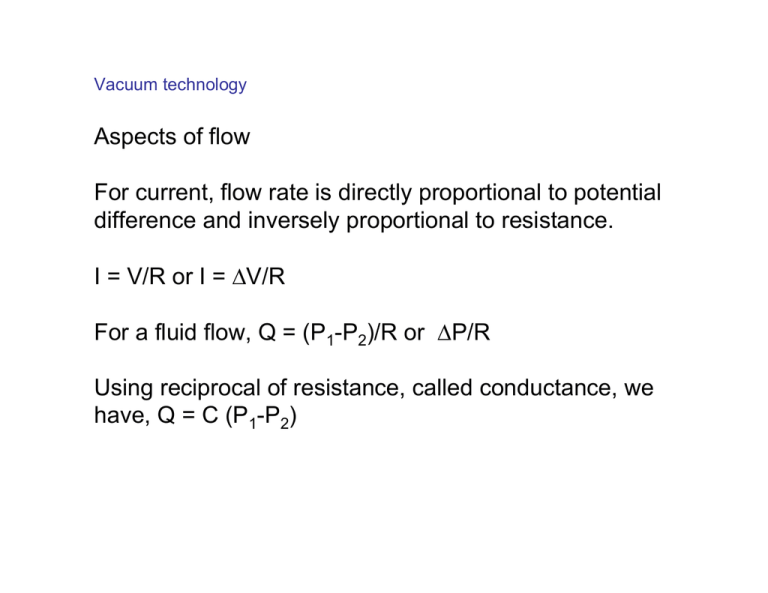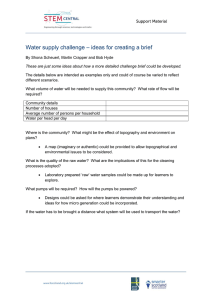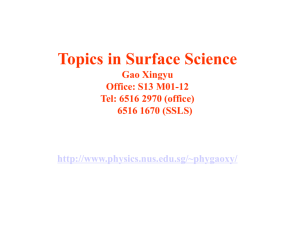Aspects of flow For current, flow rate is directly proportional to
advertisement

Vacuum technology Aspects of flow For current, flow rate is directly proportional to potential difference and inversely proportional to resistance. I = V/R or I = V/R For a fluid flow, Q = (P1-P2)/R or P/R Using reciprocal of resistance, called conductance, we have, Q = C (P1-P2) There are two kinds of flow, volumetric flow and mass flow Volume flow rate, S = vA v – the average bulk velocity, A the cross sectional area S = V/t, V is the volume and t is the time. Mass flow rate is S x density. G = vA or V/t Mass flow rate is measured in units of throughput, such as torr.L/s Throughput = volume flow rate x pressure Throughput is equivalent to power. Torr.L/s (g/cm2)cm3/s g.cm/s J/s W It works out that, 1W = 7.5 torr.L/s Types of low 1. Laminar: Occurs when the ratio of mass flow to viscosity (Reynolds number) is low for a given diameter. This happens when Reynolds number is approximately below 2000. Q ~ P12-P22 2. Above 3000, flow becomes turbulent Q ~ (P12-P22)0.5 3. Choked flow occurs when there is a flow restriction between two pressure regions. Assume an orifice and the pressure difference between the two sections, such as 2:1. Assume that the pressure in the inlet chamber is constant. The flow relation is, Q ~ P1 4. Molecular flow: When pressure reduces, MFP becomes larger than the dimensions of the duct, collisions occur between the walls of the vessel. Q~P1-P2 There are also other flows such as surface diffusion, permeation and diffusion of one gas through another. Different kinds of flow patters Number of molecules striking unit area from all sides, n = [3.5 x 1022 P]/(MT)0.5 per cm2 per s To convert this to volume that strikes per unit area we need to divide by number density. S = n/N = 3640 (T/M)0.5 cm3/s . cm2 For air at RT, this gives, 3640(295/28.7) =11.6 L/s.cm2 Flow through an orifice Assume the flow through an orifice as shown below. Pressure in the top chamber is constant and it is very small or near zero below. The flow through orifice is, A x 11.6 L/s., A is the area in sq. cm. Molecules come to the orifice from all angles, but the flow can be represented in terms of a velocity. 11.6 L/cm2.s = 11,600 cm3/cm2.s = 116 m/s Conductance C = Q/(P1-P2) = pvA/ p P is the pressure, v is the velocity, A cross sectional area and p is the pressure difference. Pumping speed In the case of an orifice, this can be given as, S = C = Q/P as P2 is much smaller than P1. For constant pumping speed, S = Vln(P1/P2)/(t1-t2) V is the volume of the chamber, P1 and p2 are two pressure points and t1 and t2 are times at which these pressure points occurred. How to measure pumping speed? S = Q/P-Po, P is the pressure when gas is leaked and Po is the ultimate pressure. Pumps There is no single pump for UHV technology. Various pumps are used to take the system from atmosphere to UHV Time for pumping This is a difficult parameter to calculate or predict in view of several aspects such as out gassing (virtual leak). When one disregards outgassing, -Vdp/dt = Sp T = (V/S)ln(Po/Pf) This is valid only in the high pressure region, above 10 torr and above this rage many factors, such as permeation, outgassing, etc. become important. Typical vacuum system Virtual leaks There are several possibilities of such leaks in every vacuum system. An example, Typical vacuum system and process of evacuation Process of evacuation Initial pumping Crossover region Coarse vacuum pumps Rotary pumps Mechanical diagrams Double stage pump Pumping speed Diffusion (vapour jet) pumps Vapour streams Diffstack pump Variation of pumping speed UHV Chamber Back streaming Turbomolecular Pumps Why a turbo is better? Cryo Pumps Getter Pumps Ion Pumps UHV Instrumentation Flanges Valves UHV fittings Feedthroughs, view ports, gas admittance valves Pressure measurement, mechanical Capacitance A chamber contains all these, in addition to your experiment!





